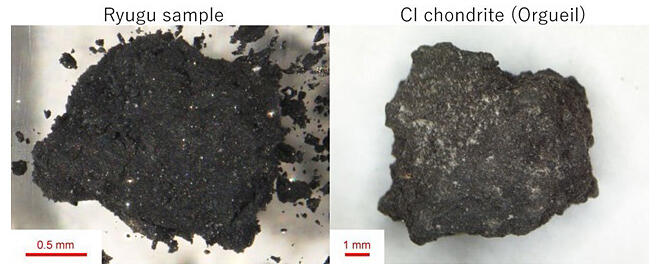Graduate Student Kana Amano (at the time of research, currently a Visiting Researcher) and Professor Tomoki Nakamura of the Department of Earth Science at Tohoku University in joint research with the National Institute of Advanced Industrial Science and Technology (AIST) and The University of Tokyo, examined the Ryugu asteroid samples collected by the space probe Hayabusa 2. The research group revealed what had made the rocks darker than other primitive meteorites from other asteroids of the same type and devised and implemented a method to measure reflectance spectra without exposing the samples to Earth's atmosphere. Based on comparisons of reflectance spectra and mineral compositions of meteorite samples heated under various conditions, it was found that the Earth's atmospheric effects on the meteorites produced color differences between the Ryugu and meteorite samples. The study revealed that when performing spectral analysis on meteorites, changes in their characteristics caused on Earth need to be considered. The study findings were published in the December 6 issue of Science Advances, one of the journals issued by the American Association for the Advancement of Science (AAAS).

©JAXA and Kana Amano et al.
Scientists have long expected asteroids to provide important knowledge in revealing how the constituents of our solar system formed. It has been speculated that the minerals (and organic compounds) found in asteroids include information about the primitive stage of the history of the solar system.
The space probe Hayabusa 2 brought back samples from the asteroid Ryugu. The state of these samples flowing in space was supposed to have been maintained, as they had not experienced any alteration under the influence of Earth's environment. The Ryugu samples are mainly composed of hydrous minerals. With regard to their classification based on the constituent minerals of meteorites, they have been revealed to be similar to meteorites of the CI type.
However, their reflectance spectra differ in that the Ryugu samples are much darker than other CI-type meteorites. In terms of their reflectance, which is based on the wavelength region visually recognizable with the human eye, the difference is as large as two times. However, the reason for this phenomenon was not known.
For this study, the research group established a method to measure reflectance spectra without exposing the samples to Earth's atmosphere. They measured the reflectance spectra of the Ryugu samples, which had just been brought back from space and had not been exposed to Earth's atmosphere. Concurrently, they compared the samples with a CI-type meteorite (the Orgueil meteorite that fell to Earth in 1864 and was collected in France) that had similar constituents.
Previous studies had demonstrated that meteorites of the CI type became darker when they were heated. Therefore, the research group heated the CI-type meteorites at various temperatures for different durations under vacuum and reductive conditions. Then, they obtained the reflectance spectra of these heated CI-type meteorite samples without exposing them to Earth's atmosphere and compared the results with those of the Ryugu samples.
As a result, the reflectance spectra of the CI-type samples heated at 300 degrees Celsius were the most similar to those of the Ryugu samples. The research group confirmed that heating the CI-type samples to 300 degrees Celsius had removed the water molecules and caused reduction of the iron within the hydrated minerals of the samples, which reproduced the characteristics of the Ryugu samples.
It was found that the CI-type meteorite changed its reflectance spectrum from its space-bound state to brighter as it reacted with water and oxygen in the Earth's atmosphere.
In future research studies, we can expect that the accuracy of identifying the constituents in asteroids through measurements of their reflectance spectrum will be enhanced by taking into account the alteration of the meteorites in Earth's environment.
This article has been translated by JST with permission from The Science News Ltd. (https://sci-news.co.jp/). Unauthorized reproduction of the article and photographs is prohibited.




